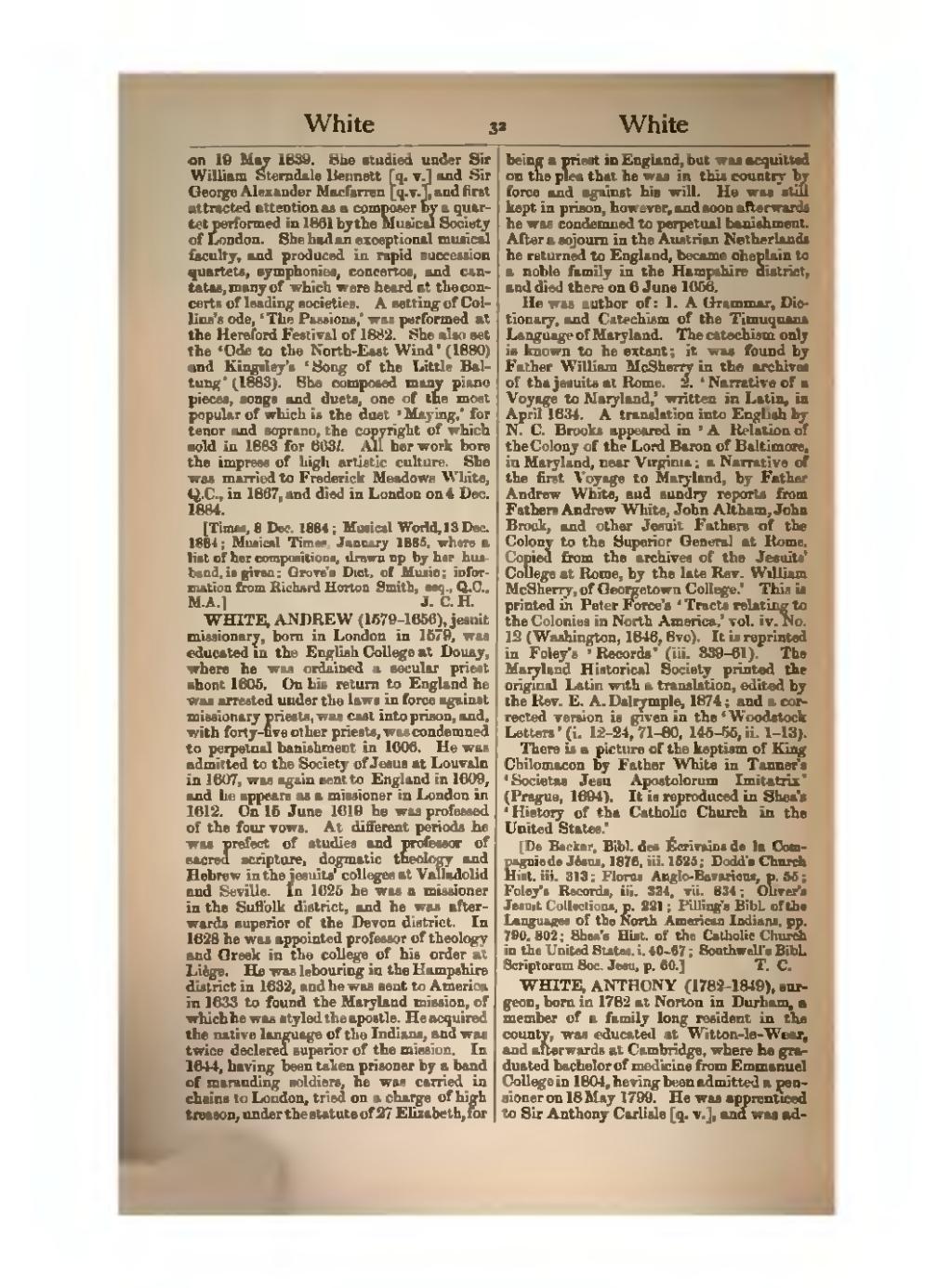on 19 May 1839. She studied under Sir William Sterndale Bennett [q. v.] and Sir George Alexander Macfarren [q. v.], and first attracted attention as a composer by a quartet performed in 1861 by the Musical Society of London. She had an exceptional musical faculty, and produced in rapid succession quartets, symphonies, concertos, and cantatas, many of which were heard at the concerts of leading societies. A setting of Collins's ode, ‘The Passions,’ was performed at the Hereford Festival of 1882. She also set the ‘Ode to the North-East Wind’ (1880) and Kingsley's ‘Song of the Little Baltung’ (1883). She composed many piano pieces, songs and duets, one of the most popular of which is the duet ‘Maying,’ for tenor and soprano, the copyright of which sold in 1883 for 663l. All her work bore the impress of high artistic culture. She was married to Frederick Meadows White, Q.C., in 1867, and died in London on 4 Dec. 1884.
[Times, 8 Dec. 1884; Musical World, 13 Dec. 1884; Musical Times, January 1885, where a list of her compositions, drawn up by her husband, is given; Grove's Dict. of Music; information from Richard Horton Smith, esq., Q.C., M.A.]
WHITE, ANDREW (1579–1656), jesuit missionary, born in London in 1579, was educated in the English College at Douay, where he was ordained a secular priest about 1605. On his return to England he was arrested under the laws in force against missionary priests, was cast into prison, and, with forty-five other priests, was condemned to perpetual banishment in 1606. He was admitted to the Society of Jesus at Louvain in 1607, was again sent to England in 1609, and he appears as a missioner in London in 1612. On 15 June 1619 he was professed of the four vows. At different periods he was prefect of studies and professor of sacred scripture, dogmatic theology and Hebrew in the jesuits' colleges at Valladolid and Seville. In 1625 he was a missioner in the Suffolk district, and he was afterwards superior of the Devon district. In 1628 he was appointed professor of theology and Greek in the college of his order at Liège. He was labouring in the Hampshire district in 1632, and he was sent to America in 1633 to found the Maryland mission, of which he was styled the apostle. He acquired the native language of the Indians, and was twice declared superior of the mission. In 1644, having been taken prisoner by a band of marauding soldiers, he was carried in chains to London, tried on a charge of high treason, under the statute of 27 Elizabeth, for being a priest in England, but was acquitted on the plea that he was in this country by force and against his will. He was still kept in prison, however, and soon afterwards he was condemned to perpetual banishment. After a sojourn in the Austrian Netherlands he returned to England became chaplain to a noble family in the Hampshire district, and died there on 6 June 1656.
He was author of: 1. A Grammar, Dictionary, and Catechism of the Timuquana Language of Maryland. The catechism only is known to be extant; it was found by Father William McSherry in the archives of the jesuits at Rome. 2. ‘Narrative of a Voyage to Maryland,’ written in Latin, in April 1634. A translation into English by N. C. Brooks appeared in ‘A Relation of the Colony of the Lord Baron of Baltimore in Maryland, near Virginia; a Narrative of the first Voyage to Maryland, by Father Andrew White, and sundry reports from Fathers Andrew White, John Altham, John Brock, and other Jesuit Fathers of the Colony to the Superior General at Rome. Copied from the archives of the Jesuits' College at Rome, by the late Rev. William McSherry, of Georgetown College.’ This is printed in Peter Force's ‘Tracts relating to the Colonies in North America,’ vol. iv. No. 12 (Washington, 1846, 8vo). It is reprinted in Foley's ‘Records’ (iii. 339–61). The Maryland Historical Society printed the original Latin with a translation, edited by the Rev. E. A. Dalrymple, 1874; and a corrected version is given in the ‘Woodstock Letters’ (i. 12–24, 71–80, 145–55, ii. 1–13).
There is a picture of the baptism of King Chilomacon by Father White in Tanner's ‘Societas Jesu Apostolorum Imitatrix’ (Prague, 1694). It is reproduced in Shea's ‘History of the Catholic Church in the United States.’
[De Backer, Bibl. des Écrivains de la Compagnie de Jésus, 1876, iii. 1525; Dodd's Church Hist. iii. 313; Florus Anglo-Bavaricus, p. 55; Foley's Records, iii. 334, vii. 834; Oliver's Jesuit Collections, p. 221; Pilling's Bibl. of the Languages of the North American Indians, pp. 790, 802; Shea's Hist. of the Catholic Church in the United States, i. 40–67; Southwell's Bibl. Scriptorum Soc. Jesu, p. 60.]
WHITE, ANTHONY (1782–1849), surgeon, born in 1782 at Norton in Durham, a member of a family long resident in the county, was educated at Witton-le-Wear, and afterwards at Cambridge, where he graduated bachelor of medicine from Emmanuel College in 1804, having been admitted a pensioner on 18 May 1799. He was apprenticed to Sir Anthony Carlisle [q. v.], and was ad-
